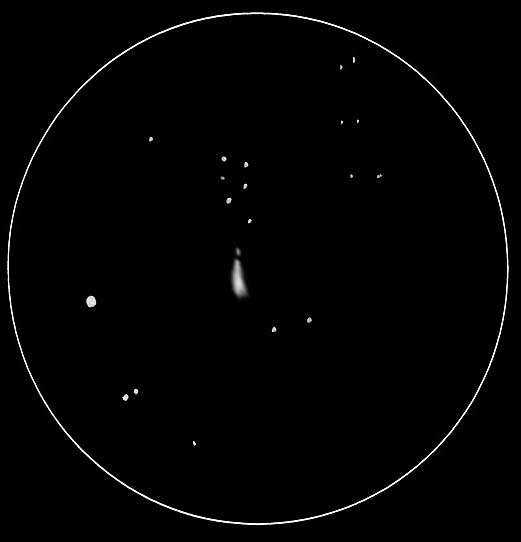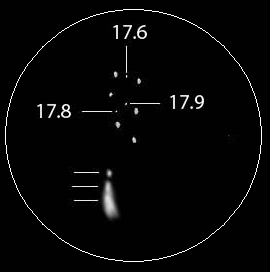







Eye Guards for small eyepieces
If you have Zeiss Orthoscopics, Baader Genuine Orthoscopics, University Optics HD Orthos, Parks Gold, or something similar. The lack of an eyepiece guard can hinder your observation a bit as you tend to cup your hand around the eyepiece to shield off ambient light. You can get one of these eyepiece guards from Agena Astro or here at ScopeStuff (Part EYU1) and stretch a little over the eyepiece. You will also need to get a 36mm cap from the same place to cover the eyepiece with the guard, so you don't have to take it off every time you are done observing.
These eyepieces will work with these eye guards;
- Zeiss ZAO-II and ZAO-I Orthoscopics (right)
- Baader Genuine Orthos (2nd from right)
- University Optics HD Orthos
- Antares Orthos
- Parks Gold Series Plossls (left)
- Vintage Zeiss 0.965" Orthos (middle)
- Vintage Takahashi 0.965" Orthos (second from left)
Observing In The "Dark"
Observing Vests from Dark Skies Apparel. If you are a serious deep sky observer. You MUST get one of Dark Sky Apparel. Using the hood easily increases your visual acuity and goes at least 1/4 magnitude deeper if not more. A very experienced observer at a dark site, I can easily go 0.2 magnitude deeper with than without it. Unfortunately, the vests aren't available at the moment.
The vest features 8 eyepiece pockets (4 large, large enough for a 31mm Nagler or 21mm Ethos) and 4 medium. I put my eyepieces in my pockets to keep them close to my body for three reasons.
1. I can easily change eyepieces while I'm on the ladder.
2. When I go to someone else's scope, I can pop in my favorite eyepiece, with permission of course.
3. The eyepieces are warmer and free from dew.
Photos used with permission from Dark Sky Apparel.
A large eyepiece, such as a TeleVue Ethos, in the lower row, which contains 4 large pockets, two on each side.
The bottom row has 4 large pockets, the middle row has 4 medium pockets and the top row for writing instruments and reading glasses.
The hood is attached to the vest so it is with you all the time. It is oversized so it would totally shield any ambient light from your eyes and eyepiece. It also gives enough room, so you won't fog up your eyepieces while using and breathing in cold high humidity environments.
Observing
Notebook
Click on this link for a sample notebook page. I print these with page numbers and on both sides on good paper, such as 28 lb weight (to prevent see though), and bring the pages to Kinkos or someplace similar to have the pages coil bound. Make sure that they are coil bound, not comb bound or anything else. Coil binding will allow you to completely fold the book on itself without splitting.

Electronic Books in the
field
I have found that using a netbook or a laptop of similar weight instead of paper observing guides can be quite effective. My old Sony VIAO laptop, which is actually netbook size, has a great display with a wide range of brightness. To create a pleasing dim light for viewing at very dark sites, I use two pieces of red transparent plastic sheets from TAP Plastics and mount them with gaffers tape. Even at the lowest setting and with white stars on a black background, the display is easier on the eyes than using an adjustable red LED light on a white paper chart. I was pleasantly surprised by this setup. I can even hold the laptop on the "spine" like a book, and rotate the page to be on the left or right, depending on my preference.
I have also updated all of my downloadable guides so they can be inverted. Most PDF readers have an invert functionality, and I personally use FoxIt reader. By rotating the view and using full screen, I eliminate any borders or scroll bars, ensuring that the entire screen is black.
I have also taken some photographs showing the laptop screens.
Without red transparencies showing a screen with no borders!
Display brightness at max
setting. 2 sheets of red transparencies (1/8" thick)
Display brightness at the
lowest setting. Note that you can't see anything!
Going DEEP with simple
eyepieces
If you want to go DEEP, use low glass count eyepieces, such as Orthoscopics.
2009 Golden State Star Party
Observation details:NGC 6745 (triple galaxy system) in Lyra was observed when it was nearly overhead. The observation took place under NELM 6.9 skies, with average seeing conditions and above-average transparency. A 22" f/4 reflector telescope was used for this observation.
Observation results:
The images on the left were captured using a 6mm Ethos, while the images on the right were taken with a 6mm Zeiss ZAO-II, both providing approximately 383x magnification. Notably, the details of the triple galaxy system were more distinctive in the Zeiss, with the three cores being more evident. The asterism of the upside-down house revealed six stars when observed through the Ethos and nine stars when observed through the Zeiss. This difference was confirmed by at least five other observers, including a beginner.
Eyepiece recommendation:
While the Zeiss eyepiece is both expensive and difficult to find due to being out of production, a 6mm University Optics HD orthoscopic was included in the comparison. This eyepiece demonstrated performance levels that fell between the Ethos and the Zeiss, leaning slightly more towards the Zeiss. Based on this comparison, it is strongly recommended to consider the Baader Genuine Orthoscopics or UO HD Orthoscopics, as they offer similar performance to the Zeiss at a more affordable price.
Additional note: The Ethos eyepiece stands out for its ability to reveal deeper views compared to other wide-field eyepieces. Therefore, it serves as a reference standard for wide-field observations.


Update (Sept 2011): I have conducted a comparison between the Delos and the Ethos eyepieces and found that the Delos provides slightly better performance. During my observation sessions of the objects Hickson 99 and IC 1296 under NELM 7.5 skies, specifically focusing on Components D (magnitude 17.4) and E (magnitude 17.7), I consistently observed that the 6mm ZAO-II allowed me to hold the images with averted vision 100% of the time, while the 6mm Ethos allowed it only 50% of the time. With the Delos, I was able to hold the images about 75% of the time. This observation was confirmed by other observers, with one confirming the result the first time around and a different observer confirming it the second time. It was also noted that IC 1296 was slightly more apparent with the Delos compared to the Ethos. For more details, you may refer to my Observing Report from OSP.
